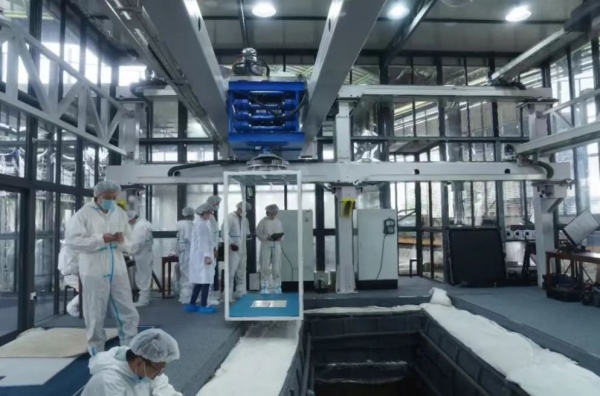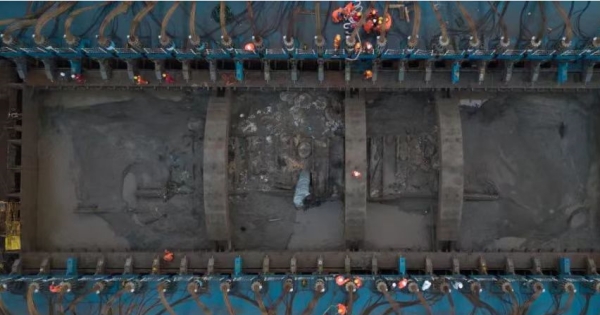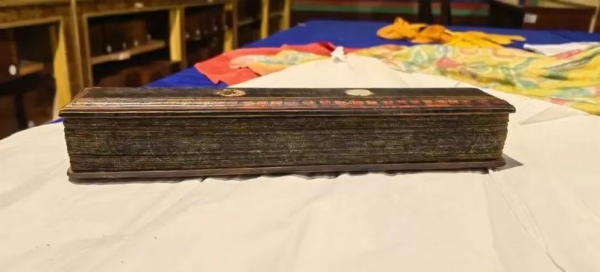China Electronic Technology Group Corporation (CETC) has given full play to hi-tech in archaeology and cultural relics protection.
During the Spring Festival vacation, CETC technical experts improved a smart protective door system, realized preventive preservation of the cultural relics and monitored and prevented illegal invasion of the Dunhuang Mogao Grottoes in Northwest China’s Gansu Province.
A security situation awareness platform protecting the cultural relics was also launched in the caves. It protects not only the caves but also the grotto temples and even tourists, in whole-process management of prevention, alarm and treatment.
Technical experts of CETC explained that real-time awareness and prediction as well as alarms in the Gobi Desert can greatly improve risk management, and control and lower the costs of human inspection.
The improvement of security risk prevention capacity owed much to upgrading of digital and intelligent transformation.
Relying on its information technology, CECT developed various kinds of protection equipment and provided diversified digital services targeted at cultural relics and cultural heritages.
The company also inked a strategic cooperation agreement with the National Cultural Heritage Administration on accelerating development and upgrading of special equipment for cultural relic protection and strengthening development and application of key technologies for smart museums.
Take the archaeological work of the Sanxingdui Ruins in Southwest China’s Sichuan Province as an example. More than 10,000 cultural relics has been found in the six newly-discovered sacrificial pits since the new round of archaeological work started.
According to CETC technical experts, field archaeology was widely seen in the past days as involving surveys and excavations in the open air. Things are different now as the archaeological experiment laboratory has been moved to the recovery site, providing 360-degree protection for special, sensitive and fragile relics.
CETC has developed a platform integrating multiple functions for archaeological excavations and has set up on-site archaeological laboratories, allowing archaeologists to perceive things unable to be seen with the naked eye with devices like electronic microscopes, three-dimensional laser scanners and hyperspectral scanners.

A view of the on-site archaeological laboratory equipped with devices like an electronic microscope, a three-dimensional laser scanner and a hyperspectral scanner [Photo/sasac.gov.cn]
Underwater archaeology has been a global puzzle. The archaeological salvage of the shipwreck known as the Yangtze River Estuary No 2 Ancient Vessel was even more challenging as the original microorganism balance may be broken once the vessel was removed from the underwater mud, leading to deterioration of the cultural relics.
In response to the issue, CETC researchers developed a smart cultural relic protection cabin which has the same environmental condition as the original shipwreck thanks to devices monitoring and controlling ventilation, water temperature, and soil humidity.
A fully-automated spraying system was innovatively used in study of the ancient vessel so that it was fully covered, which was like putting on a low-temperature and pure water facial mask for the vessel to provide it with a clean and stable environment.

A view of the Yangtze River Estuary No 2 Ancient Vessel [Photo/sasac.gov.cn]
CETC also contributed to archaeology of the palm leaf manuscripts collected in the Potala Palace.
There are quite few palm leaf manuscripts in the world and many of them were damaged because of various kinds of diseases as the manuscripts were carved on Bedoro leaves, a situation calling for accurate and smart risk management and control.
CETC developed a capsule installed with a real-time monitoring system to control preservation of the manuscripts and joined hands with the China Academy of Cultural Heritage to launch an electrostatic adhesion device to reduce human-caused damage during transference and page-turning.

A view of the palm-leaf manuscripts in the Potala Palace.[Photo/sasac.gov.cn]
China now has released 130,000 digital ancient books and 46.65 million items collected by nationwide museums. Digital museums have become popular in the era of the Internet.
Some digital exhibitions are designed in a form of timeline.
For instance, the Three Gorges online exhibition hall has an online timeline integrating archaeology, traffic and calligraphy and drawings of the Three Gorges. The digital exhibition hall was launched in July 2022, and includes more than 1,600 digital cultural relics.
(Executive editor: Zhu Zeya)